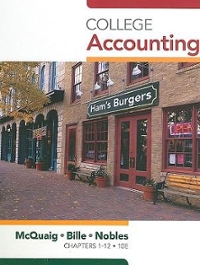Question
Question Part A: The audit risk model has become the commonly used basis for audit planning. The following are independent situations that could have an
Question Part A: The audit risk model has become the commonly used basis for audit planning. The following are independent situations that could have an effect on various components of the audit risk model. Required For each situation, identify the element(s) of the audit risk model (that is, audit risk, inherent risk, control risk, and detection risk) that is (are) most likely to be directly affected and the nature of the change in risk levels (increase or decrease) relative to a typical audit. Explain your reasoning in detail. a. A company provides all customers with the option to return unused goods within two weeks of the purchase. b. In the current year, the company began performing credit checks for all new customers. The customers? credit ratings were used to determine credit limits for the customers. c. A client?s sales team is primarily compensated on a commission basis. Commissions are determined on a percentage-of-sales basis. d. All cheques greater than a pre-determined limit require the signature of the controller and the chief financial officer. e. In order to raise capital, in the current year the owner-manager of a business sold 20% of the common shares to a private-equity investor. The owner will remain actively involved in the business. The private-equity investor will not actively partake in the daily management of the business. f. An auditor tests a control and observes several compliance deviations. g. In the past two prior-year audits, the auditor has identified several material overstatements in inventory. ? Part B: Required For each of the following independent situations, state whether the CGA has violated generally accepted auditing standards and/or the CGA-Canada Code of Ethical Principles and Rules of Conduct or Independence Standard and explain your reasoning in detail. a. Emily, CGA, owns a material amount of units in a mutual fund that owns stock in Emily?s largest audit client. Reading the mutual fund?s most recent financial report, Emily learned that the mutual fund significantly increased its holdings in her client. b. Martha, CGA, has a practice with two departments. One department performs assurance services and the other performs bookkeeping services. One of her publicly accountable audit clients lost its controller and the bookkeeping department provided controllership services for 30 days while the company searched for a new controller. As this was an emergency, it was necessary for Martha?s firm to provide the service because it has an intimate knowledge of the client?s system. c. In an effort to expand his business, Mathew, CGA, places an advertisement in the business section of the local newspaper listing specific services he performs and his rate for performing each type of service, some of which are available for a fixed fee and others for an hourly fee, which was also stated in the advertisement. d. Howard, CGA, discovered, during the audit of his client Ignoble Enterprises Inc., that the company had failed to include a significant amount of income on last year?s corporate income tax return. Howard suggested to the controller that he submit an amended return. When the controller refused, Howard resigned from the engagement. Howard later received a letter from the successor auditor asking if Howard was aware of any circumstances that they should be aware of prior to accepting Ignoble as a client. Howard replied by letter and informed the successor auditor that Ignoble?s management failed to adjust income tax returns containing significant material errors. e. Emma, CGA and auditor for Nestco (a public company), recommends that the company improve its internal controls and accepts a 90-day engagement to design and implement new controls, and to train company staff on them. f. Harry, a CGA student, is currently employed by a CGA firm in public practice. He accepts a 15% discount on purchases from an audit client. Harry believes that he has not violated the Rules of Conduct because he is not yet a CGA member and the discount is at the same percentage that is available to the client?s own staff members. ? 
Step by Step Solution
There are 3 Steps involved in it
Step: 1

Get Instant Access to Expert-Tailored Solutions
See step-by-step solutions with expert insights and AI powered tools for academic success
Step: 2

Step: 3

Ace Your Homework with AI
Get the answers you need in no time with our AI-driven, step-by-step assistance
Get Started


